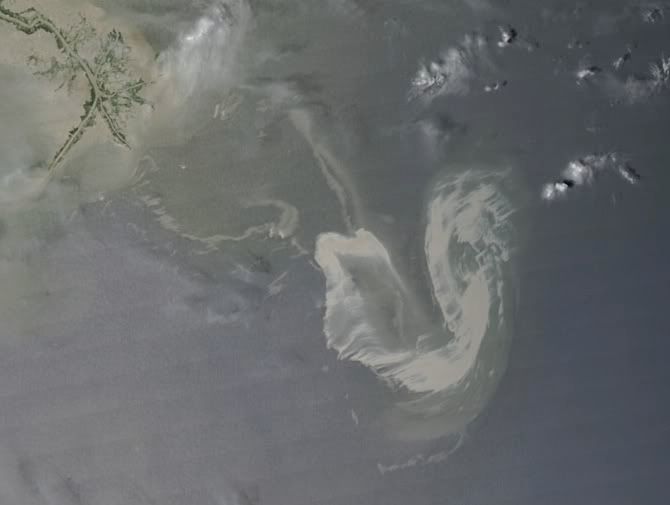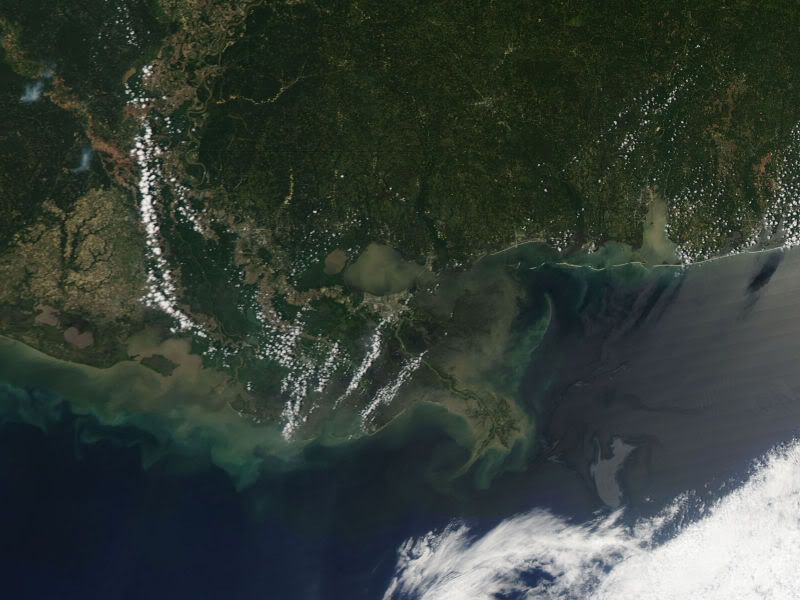Venice, Louisiana (CNN) -- The Gulf of Mexico undersea gusher has already spilled more oil than the Exxon Valdez disaster -- possibly more than twice as much, making it the largest oil spill in U.S. history -- government scientists said Thursday.
Scientists observed 130,000 to 270,000 barrels of oil on the water's surface on May 17, and think a similar amount had already been burned, skimmed, dispersed or evaporated.
That would mean 260,000 to 520,000 barrels had been leaked as of 10 days ago. The Exxon Valdez leaked about 250,000 barrels into Alaska's Prince William Sound in 1989.
The estimate came as an underwater tussle between oil and mud unfolded in BP's latest attempt to cap the runaway leak. But whether mud is able to defeat oil won't be known until later Thursday.
Federal authorities remained cautiously optimistic about the maneuver known as a top kill, which BP started Wednesday afternoon.
http://mfile.akamai.com/97892/live/reflector:45685.asx?bkup=49182
"The top kill procedure is going as planned, and it is moving along as everyone had hoped," said U.S. Coast Guard Adm. Thad Allen, who is leading the government's response to the oil spill.
A BP official said it was too early to draw any conclusions about the success of the effort.
"We appreciate the optimism, but the top kill operation is continuing through the day today -- that hasn't changed," the official said. "We don't anticipate being able to say anything definitive on that until later today."
Meanwhile, government scientists said Thursday that the undersea gusher was spewing oil at a rate of 12,000 to 19,000 barrels a day, more than twice the 5,000-barrel estimate given by BP.
The government had two different teams of scientists estimate the rate of flow using two different methods, U.S. Geological Survey Director Marcia McNutt said.
Also Thursday, sources said that Minerals Management Service Director Elizabeth Birnbaum has been fired.
A senior Obama administration official said an official announcement will be made during the president's news conference scheduled for Thursday afternoon.
The decision to fire Birnbaum comes after a recently released report highlighting what many observers have characterized as widespread corruption at the Minerals Management Service, which is part of the Interior Department.
A dramatic video feed from the ocean floor showed enormous brown plumes billowing at the well. BP Managing Director Bob Dudley described it as a "titanic arm wrestling match" between the gushing oil and the thousands of pounds of drilling mud -- a thick, viscous fluid -- being pumped in to stop the flow.
So far, "that operation is proceeding like we would expect it," Dudley said.
If the mud succeeds in pushing back the oil, BP plans to seal the well with cement.
That response is sure to generate more questions for President Obama, who has come under fire for not doing enough.
Obama fought back the criticism Thursday by announcing that he is delaying oil exploration off the coast of Alaska, canceling the sale of a lease to drill off Virginia and extending the moratorium on permits to drill any new deepwater wells for six months, a White House official said.
He has also launched a presidential commission's safety review of offshore drilling in response to the incident.
He was expected to discuss other recommendations that came from a 30-day review he ordered shortly after the April 20 explosion aboard the drilling rig Deepwater Horizon that triggered the leak and left 11 men missing and presumed dead.
"If it's successful, and there are no guarantees, it should greatly reduce or eliminate the flow of oil now streaming into the Gulf from the sea floor," Obama said after discussing the top kill procedure with Energy Secretary Steven Chu, who was in Houston, Texas, at the command center. "And if it's not, there are other approaches that may be viable."
But he didn't elaborate on what he meant by "other approaches."
No fewer than four congressional hearings were scheduled Thursday regarding the spill. The committees were set to hear from oil rig workers and their families. Lamar McKay, chairman and president of BP America, and Steven Newman, president and CEO of Transocean, owner of the oil rig that exploded and sank, were also expected to testify.
Democratic Rep. Jim Moran, head of a key House appropriations subcommittee, told Interior Secretary Ken Salazar he "will be responsible" for ensuring there isn't a repeat of the oil spill "catastrophe" in the Gulf of Mexico.
Salazar said he remains "very confident and resolute that we will solve the problem."
Early Thursday morning, the Unified Command in Louisiana said it recalled all 125 commercial vessels in Breton Sound, Louisiana, after four crew members in three vessels involved in the oil recovery operations reported feeling sick.
Medics were going boat to boat to evaluate crew members as a precaution, Lt. Cmdr. Rob Wyman said.
The four crew members, who prompted the recall, reported feeling nauseated and dizzy, and complained of headaches and chest pains, the Deepwater Horizon Incident Joint Information Center said.
The other crew members on those boats declined treatment at the dock.
"No other personnel are reporting symptoms, but we are taking this action as an extreme safeguard," Coast Guard Chief Petty Officer Robinson Cox said.
All four crew members were taken to West Jefferson Medical Center outside New Orleans. Hospital spokeswoman Taslin Alfonzo said that in addition to the four, the medical center also received three other men who were working on the spill cleanup.
The vessels were involved in cleaning up oil that has been gushing into the Gulf of Mexico since the oil rig sank about 40 miles south of Louisiana.
If BP's top kill procedure fails, an attempt would be made to contain more of the flow than is currently being siphoned through a riser insertion tool, according to Doug Suttles, the company's chief operating officer.
That would likely be followed by an attempt to place another blowout preventer on top of the existing one, which failed, he said.
"Everyone has experienced a great deal of frustration that we're 30-some odd days into this oil spill and we haven't yet contained the flow," Suttles said. But, he added, "We're doing everything we can to bring it to closure."









